Concerning the land and the body: the 2024 Faculty Art Exhibition at Fort Hays State
The show includes works in painting, printmaking, sculpture, and interior, graphic, and motion design, installed in the Moss-Thorns Gallery and the Patricia A. Schmidt Gallery Lobby through October 25.

Artists who teach at Fort Hays State University are thinking about the body and the landscape. Though human presence is often suggested in their works in the 2024 Faculty Art Exhibition, figurative pieces are few. In only three pieces from the 12 artists on display does a human face fully appear, suggesting a world in which the human influence is not only less visible, but waning in importance.
On view through October 25, the show features works in painting, printmaking, sculpture, and interior, graphic, and motion design, which hang together comfortably in the Moss-Thorns Gallery and the Patricia A. Schmidt Gallery Lobby on campus. The exhibition space is anchored at opposite ends with two large works that consider the body’s relationship to literal earth. Between the two, many other artists represented are looking similarly at the emergence, stability, and eventual absence of both subjects.
Located at one end of the larger of two galleries, a photograph by Curt Steckel depicts a hill of gravel grooved with the marks of earth-moving equipment. It is surmounted by the deep blue sky, and is exhibited alongside a small jar of gravel and dirt-stained white coveralls. The ensemble of photograph and installation is titled “Indelible Marks: Gravel Mound.” No body inhabits the flat coveralls hanging on the wall, but we’re invited to imagine a person in the photographed place doing some digging as a scientist or summer road worker.
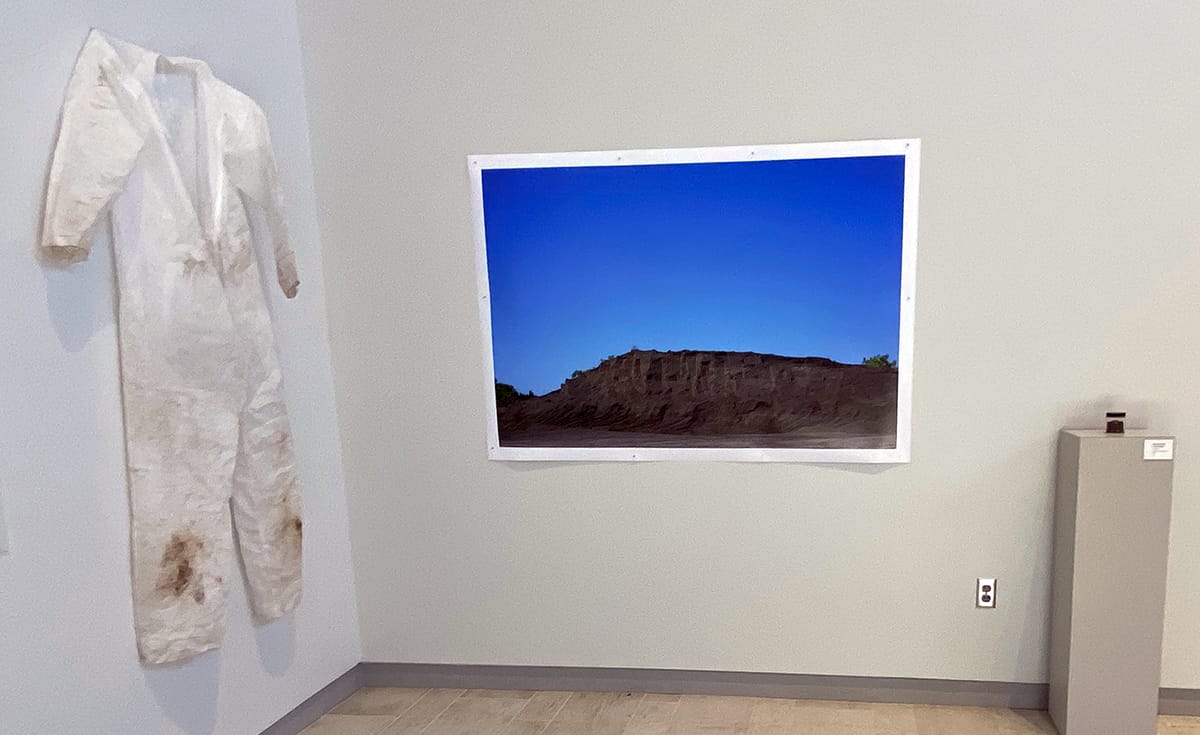
Across the space in the gallery’s other room, Jee Hwang’s 46-by-82-inch oil painting “Dive” portrays a figure embedded in dark soil mounded over the torso. The figure’s head is turned away to face the forest. Two lower legs and one arm are not yet covered, and the pink tones of flesh against the nearly black paint of the soil draw the eye back again and again. The mound and figure are backed by a sunlit forest glade, with horizontal stripes of blue, green, and yellow punctuated by the vertical bottoms of tree trunks. The trees’ crowns of leaves are cut off by the canvas’s top edge. This is clearly not a burial, but a different kind of merging with nature.

The faculty exhibition is a staple of many university galleries. It is an annual opportunity for students, faculty, and community to consider the work of those who teach in the arts. While a high level of technical ability is expected, a group exhibition gives viewers a chance to consider themes, subjects, and content beside technical virtuosity. In such a show, any theme or idea that emerges might be accidental and constructed by the viewer, or produced by artists working side-by-side on campus and sharing work in classrooms and studios.
Colin Schmidtberger, gallery curator and director, teaches interior design in the FHSU Art and Design Department. Schmidtberger designed the exhibition based on what faculty artists dropped off, using his interior design skills to stage the space. His primary concern is for students who experience the exhibition as individuals and in class groups to learn from the show.
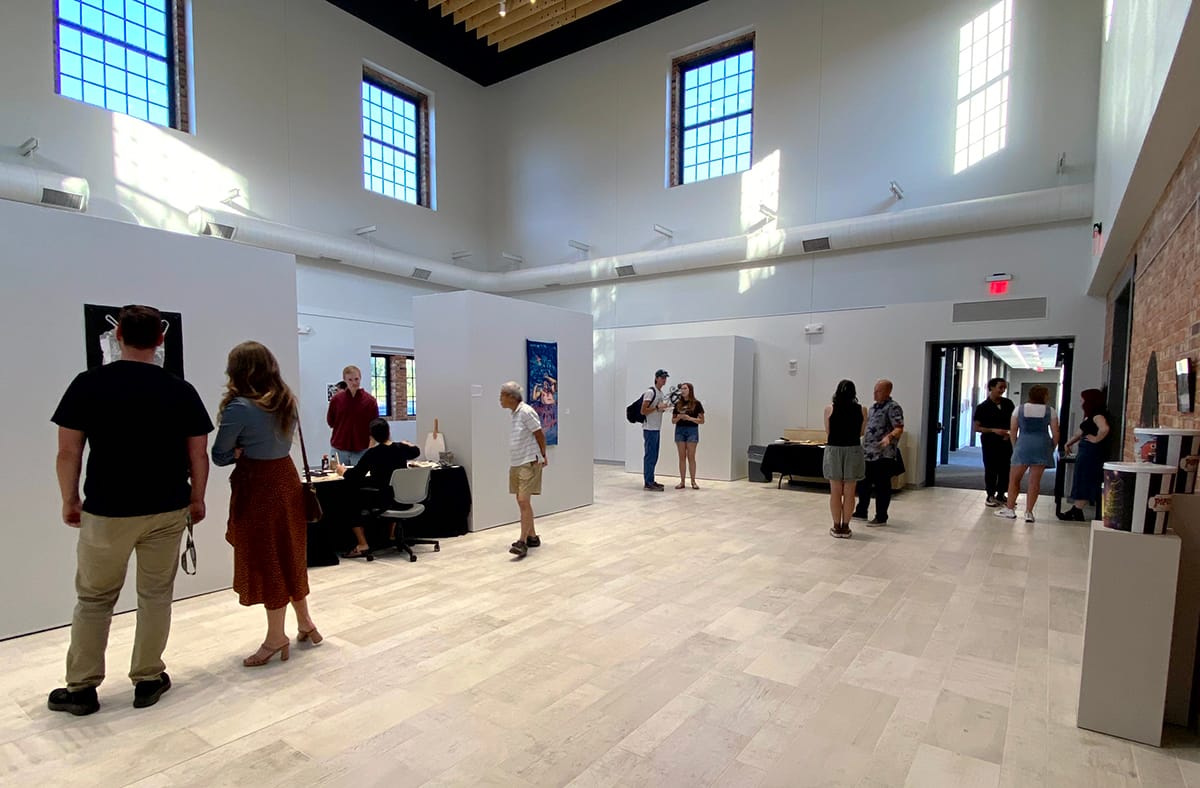
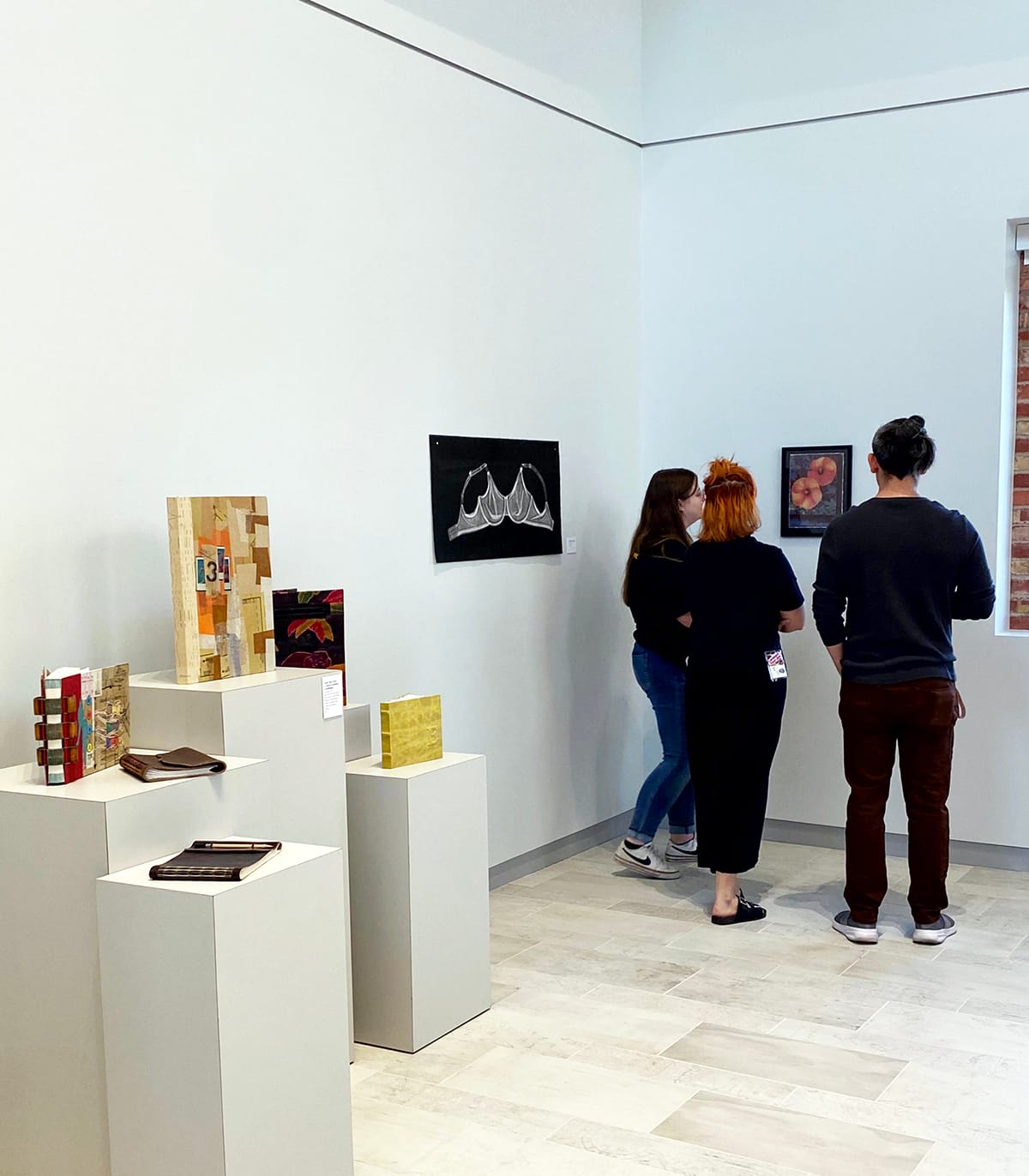
Visitors, including students and art faculty, attend the faculty exhibition opening reception. Right: Art students consider a print by printmaking professor Brian Hutchinson. Handmade books by art faculty Karrie Simpson Voth and a monoprint by Brittany Gorelick are in the foreground. Courtesy photos by Colin Schmidtberger
“The thing about our art and design department is there are so many programs – painting, printmaking, but also graphic design and animation. Students are able to see what their professors are doing,” Schmidtberger said. “We talk all the time in class, explaining processes and showing examples of how we do things, but here, they’re seeing the end of the process and who they’re learning from.”
Our free email newsletter is like having a friend who always knows what's happening
Get the scoop on Wichita’s arts & culture scene: events, news, artist opportunities, and more. Free, weekly & worth your while.
No spam. Unsubscribe anytime.
Between the photograph with installation and large painting, works by other artists bring nuance to notions of land and body as well as presence and departure.
Printmaker Brittany Gorelick’s black, white, and gray monoprints are dispersed throughout the gallery, so viewers encounter them like a returning metaphor or musical leitmotif. Gorelick has printed impressions of lingerie: negligees, filmy bras, and women’s panties. These suggest a specific, intimate body as the translucent fabric’s wrinkles and folds look worn and laundered, then put aside. These quiet, almost nostalgic pieces allow the viewer a privileged view of private garments.

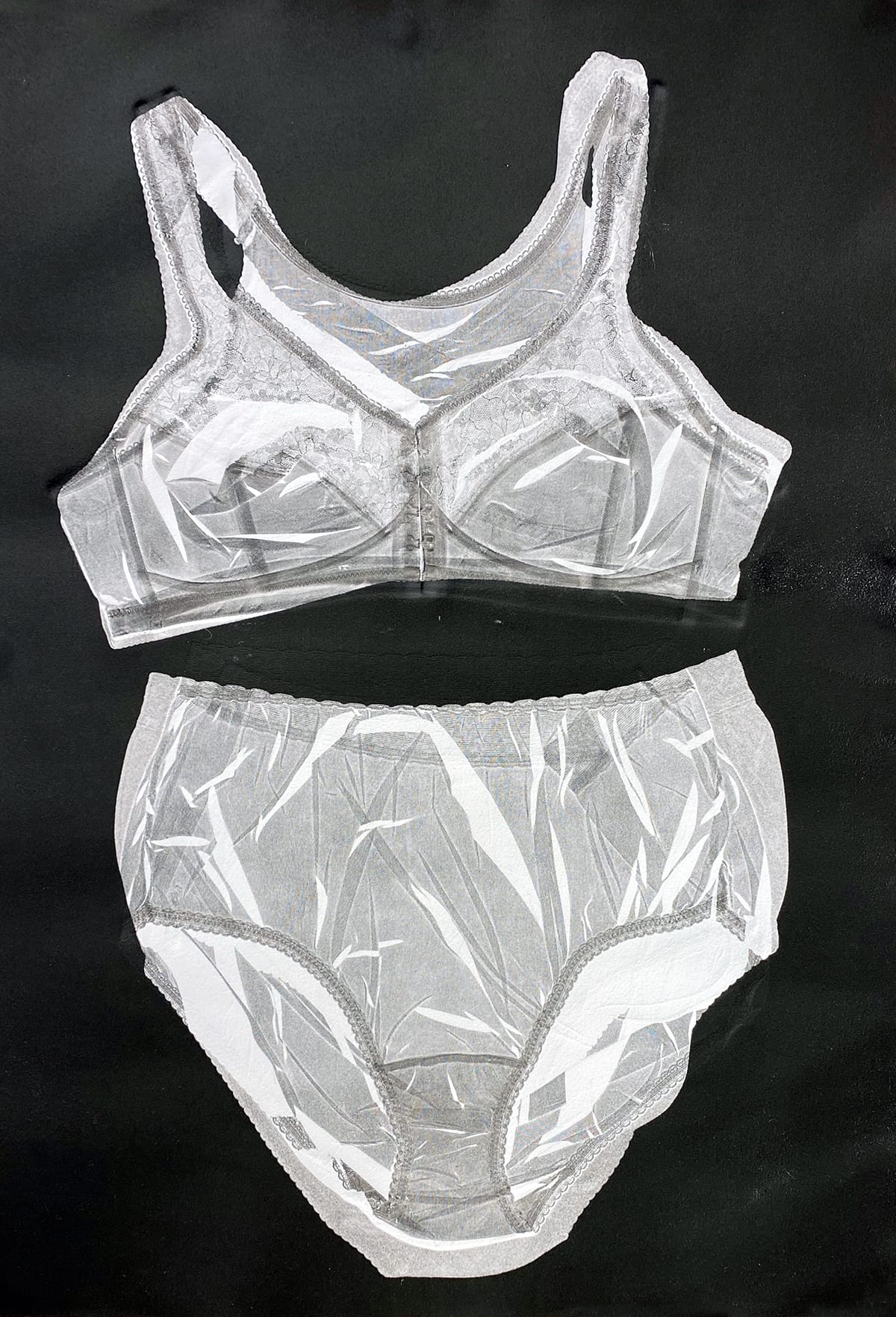
Works by Brittany Gorelick, from left: “Negligee (Impression)” monoprint, 42 x 22 inches; “Unmentionables,” monoprint, 30 x 21.5 inches. Photos by Lori Brack for the SHOUT
Gorelick also has printed a denim jacket – our ubiquitous outerwear. In “Ghost,” a white and gray cut-out jacket shape retains its seams and buttons. But in “Absence,” the viewer is left with a stark white jacket shape, flat, arms open, against a seamed and creased black background.


Works by Brittany Gorelick, from left: “Ghost,” monoprint, 27.5 x 21.5 inches; “Absence,” monoprint, 29 x 42 inches
The human shape is utterly present in “Still Standing,” a full-body ceramic sculpture in a style that Linda Ganstrom has mastered over her career. The figure stands on a large silk pillow, directly across from Hwang’s painting of a body in a mound of soil. The figure’s tilted head and open eyes convey quiet thoughtfulness despite the baroque architectural curls of clay at her breasts and belly. She wears a hoop skirt around her neck, and silk tassels and beads in colors of autumn are arranged around her feet. A green, floral, silk backdrop defines the figure’s space. The installation may suggest that the hoop skirt frame shed its fabric around the figure, or that the woman looks out from a silky, though waning, season.

The only other full-faced figure in the exhibition emerges in printmaker Brian Hutchinson’s “KiteSwoop,” a raw-edged pochoir, cyanotype, and gum bichromate print. It depicts a man standing in water fending off the plunge of a bright bird and perhaps the rain or waves surging behind him. The figure’s pink reflection is lined with ripples that may also be contour lines from a topographical map – another potential landscape reference.
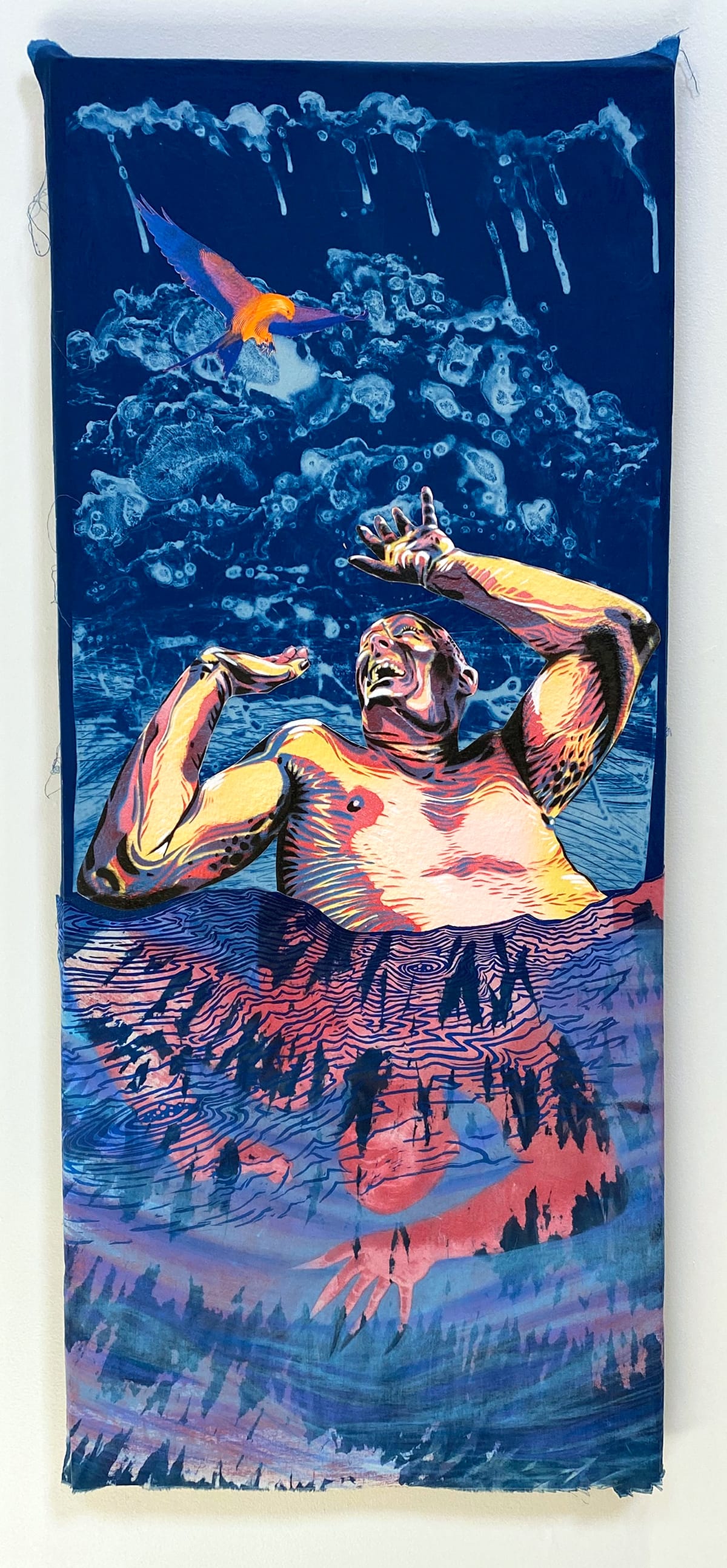
The whimsy of Thomas Giebler’s digital illustrations for “Food Fight,” a student project, as well as illustrations for a set of holiday popcorn tins, are perhaps the only literal note of light-heartedness in the show — and none of it at the expense of real people. Giebler teaches motion design and animation, one of several art programs that focus on design, including graphic design and interior design.
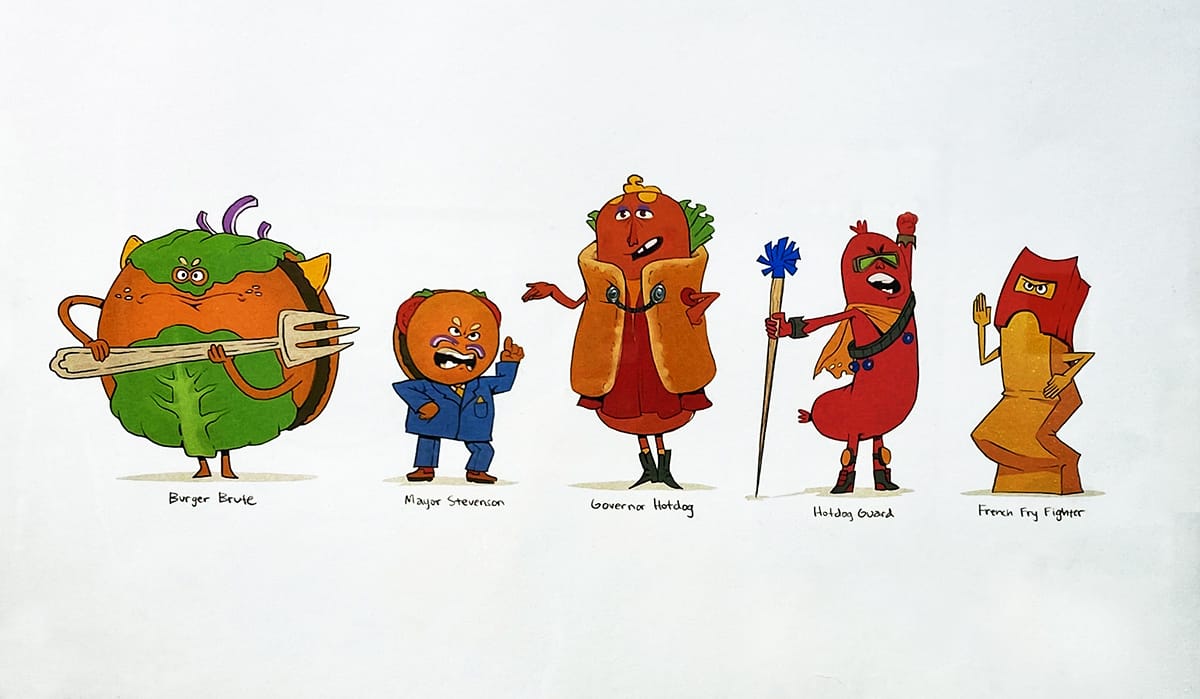
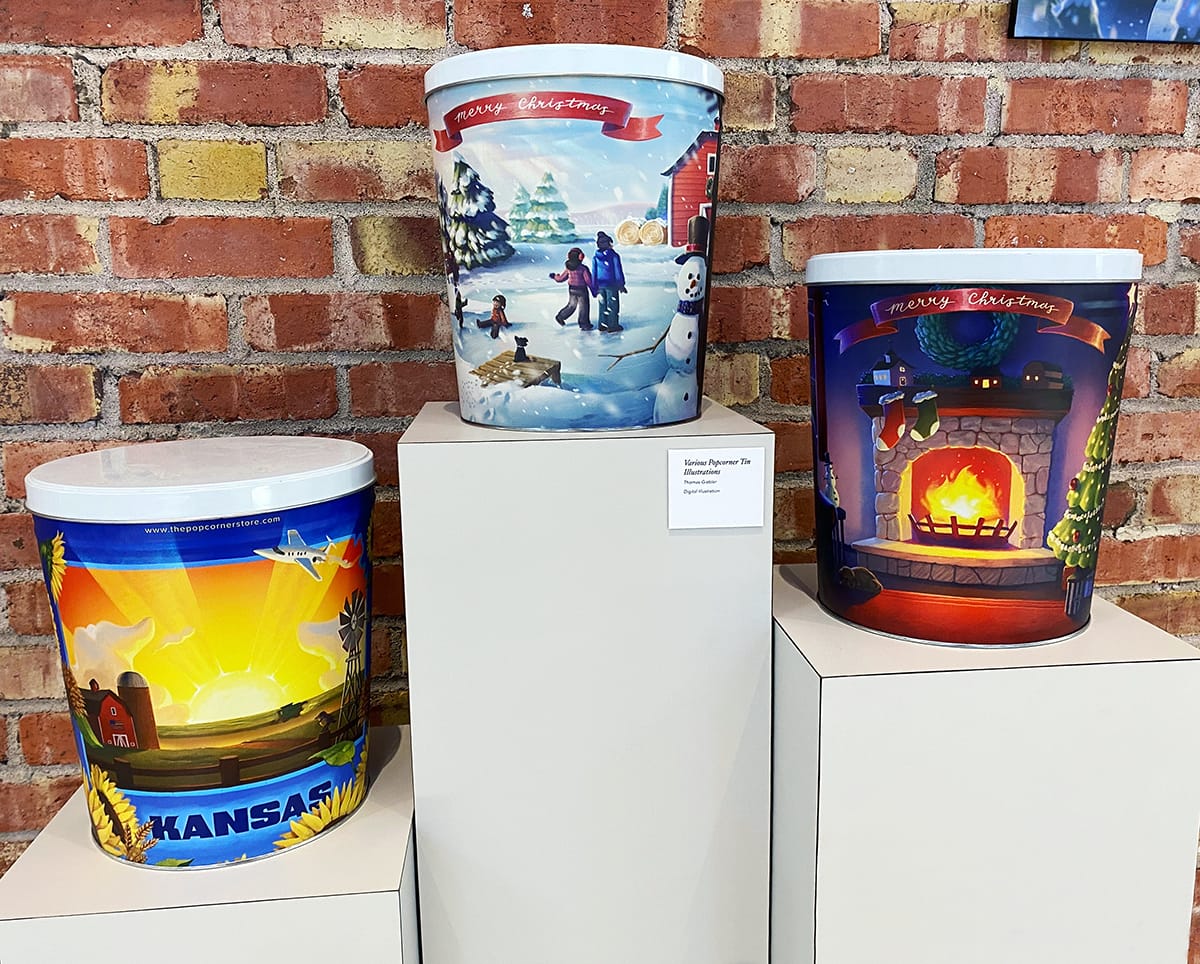
Works by Thomas Giebler, from left: “Food Fight Character Concepts,” digital illustration, 11 by 17 inches; “Various Popcorn Tin Illustrations,” digital illustration, 24 by 35 inches each. Photos by Lori Brack for the SHOUT
Other works shown by faculty in these disciplines are Schmidtberger’s interior design for a client’s home; Farheen Khan’s copper wire, bead, and rock fantasy of nature shown under glass domes; and Karrie Simpson Voth’s skillful and inviting collection of handmade books. FHSU long-time graphic design professor Chaiwat Thumsujarit’s digital illustration of a luminous “Pepper” seems both to be crumpling in decay and glowing from within.


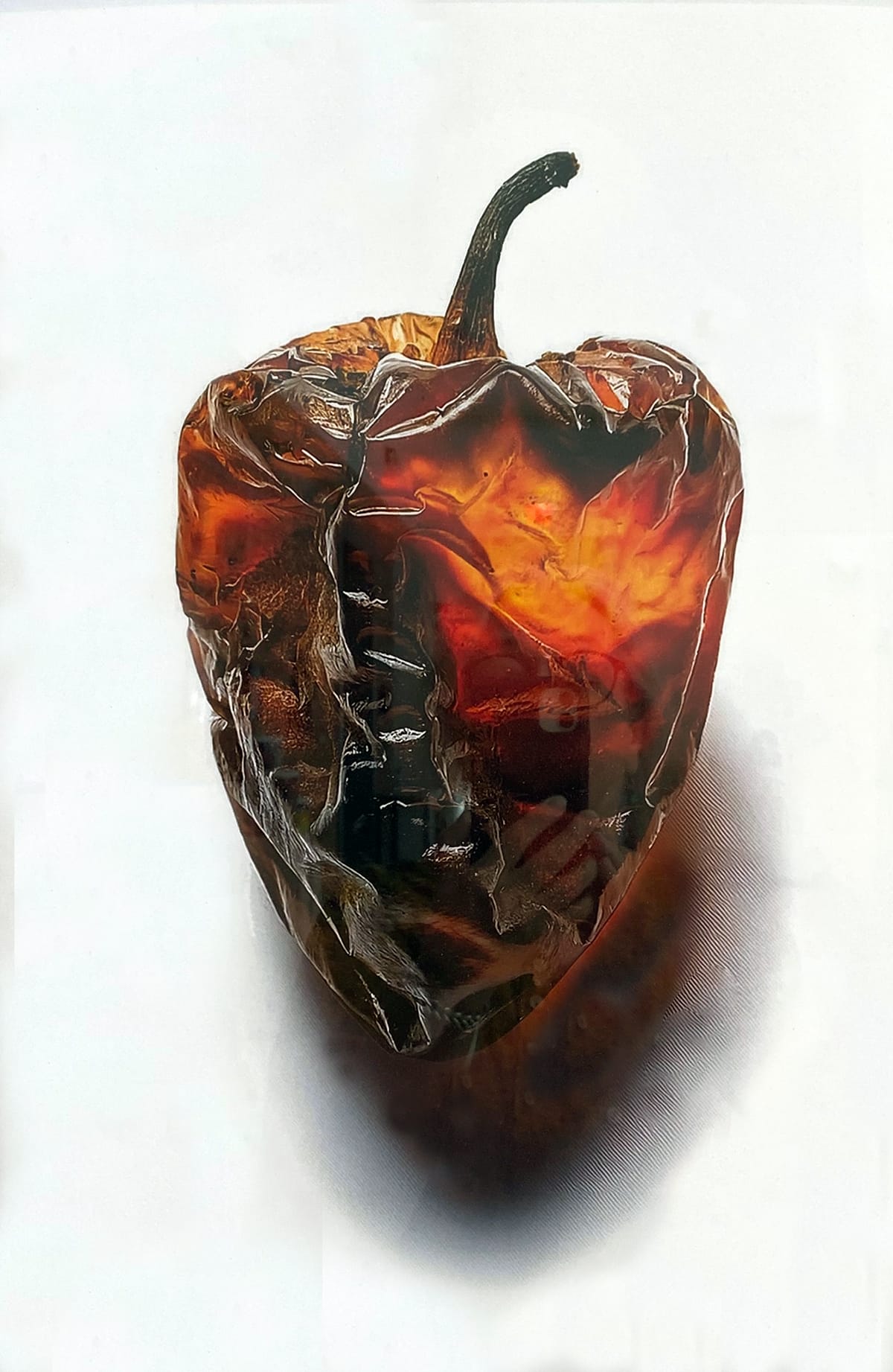

From top left: Farheen Khan, “Nature’s Detail,” copper wire, beads and rocks, 5 by 4 by 3 inches; Karrie Simpson Voth, “Leather, Paper, Stitch, A Collective Exploration in Bookbinding; Chaiwat Thumsujarit, “Pepper,” Cinema 4D, Adobe Firefly, 19.5 by 13.5 inches. Photos by Lori Brack for the SHOUT. Bottom right: Gallery director Colin Schmidtberger discusses “Custom Home Design,” Autodesk Revit, on the wall 22 by 34 inches (1/4 inch = 1 foot scale), on the pedestal 11 by 17 inches (1/8 inch = 1 foot scale) Photos by Lori Brack for the SHOUT
The landscape returns in three limestone, cast iron, steel, and resin sculptures by Danielle Robinson. The colors and materials capture western Kansas’s red-brown and tan rocky outcrops, and perhaps the yearly summer experience of highway construction where human land use is always visible. Robinson addresses current Kansas climate realities in “Hazardous Drought Conditions” – three wall-mounted panels that could be relief maps picturing the earth from above, or close-ups of parched soil at our feet. Each panel features a red safety reflector suggesting caution.

Sculptor Toby Flores casts figurines and toys as handles for a pair of two-spouted ladles, like the ones used for pouring molten metals. Among recognizable figures are the Statue of Liberty, Micky Mouse, Yoda, and Oscar the Grouch. The blackened stainless steel unites a variety of historical and cultural faces and gives them a kind of gravity. Flores’s cast-iron “Melon” and a wall-mounted aluminum and steel sculpture titled “German Pretzel and Kansas Sunflower” interpret place and land where melon vines produce huge fruit and sunflowers bloom from spring through Octoberfest.

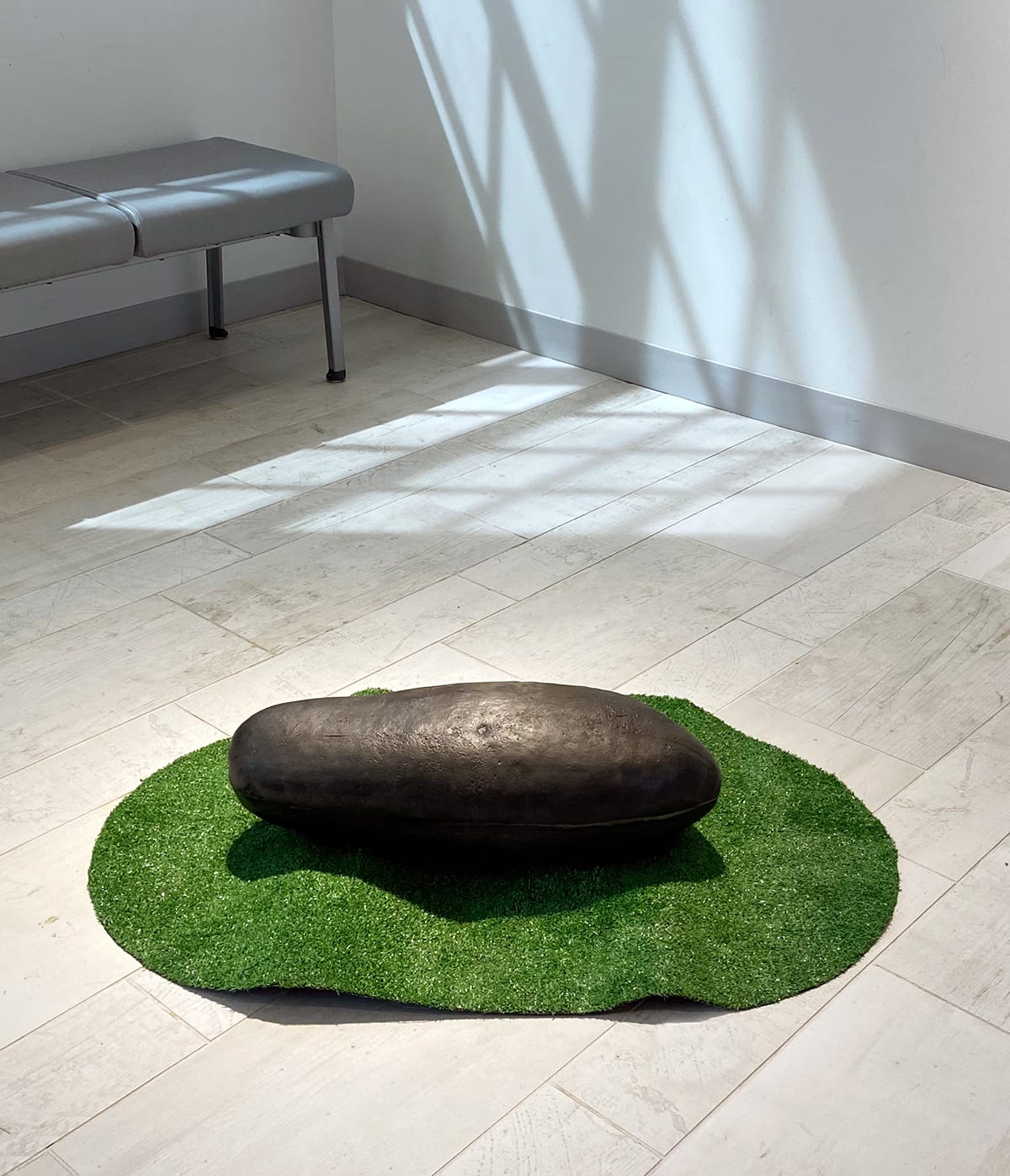
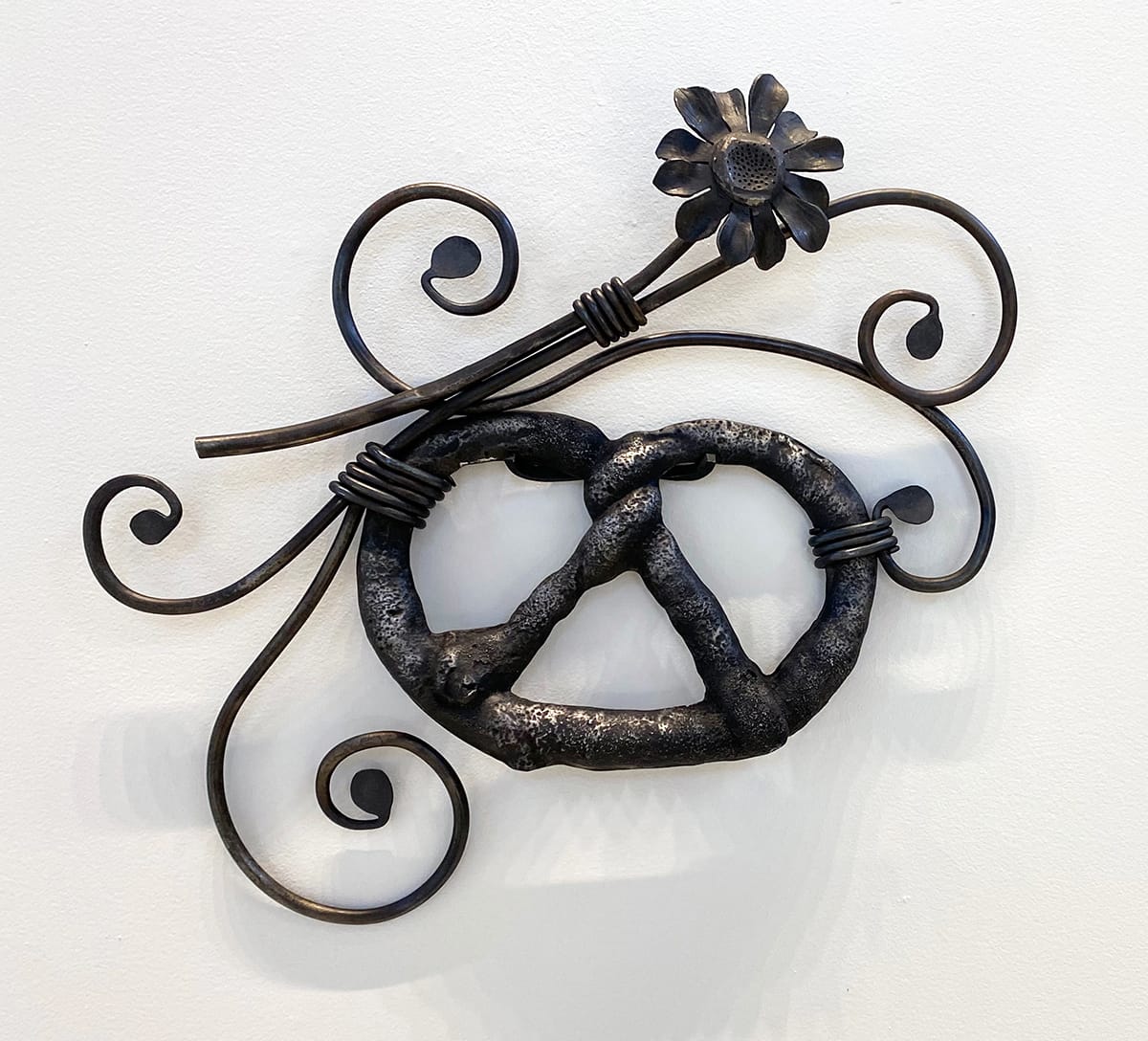
Works by Toby Flores, from left: “Ladle,” stainless steel, 23 by 6 inches; “Melon,” cast iron, 225 pounds; “German Pretzel and Kansas Sunflower,” cast aluminum and forged steel. Photos by Lori Brack for the SHOUT
The Details
2024 Faculty Art Exhibition
Sept. 13-Oct. 25, 2024 in the Schmidt Foundation Center for Art and Design on the Fort Hays State University campus, 600 Park St. in Hays, Kansas
The exhibition is on view in the Moss-Thorns Gallery of Art and The Patricia A. Schmidt Gallery Lobby. The galleries are open to the public Monday-Friday from 9 a.m.-4 p.m.
Learn more about the exhibition and view a map of the FHSU campus.
Lori Brack is a writer and arts worker based in Lucas, Kansas. She is the author of three books of poems and many essays in anthologies and journals. Links to her writing and full bio are at www.loribrack.com.
Support Kansas arts writing
The SHOUT is a Wichita-based independent newsroom focused on artists living and working in Kansas. We're partly supported by the generosity of our readers, and every dollar we receive goes directly into the pocket of a contributing writer, editor, or photographer. Click here to support our work with a tax-deductible donation.
❋ Derby man has the kind of voice that turns heads — and chairs
❋ Socializing while sober: how some Wichitans are cultivating alcohol-free communities
❋ As a small creative business closes, the owner mourns
❋ Painting through it: Autumn Noire on 20 years of making art
❋ How a guy from Wichita resurrected 'Dawn of the Dead'
❋ Bygone Friends University museum housed curious collections
More visual arts coverage from the SHOUT
 The SHOUTChloe Lang
The SHOUTChloe Lang
 The SHOUTThe Shout
The SHOUTThe Shout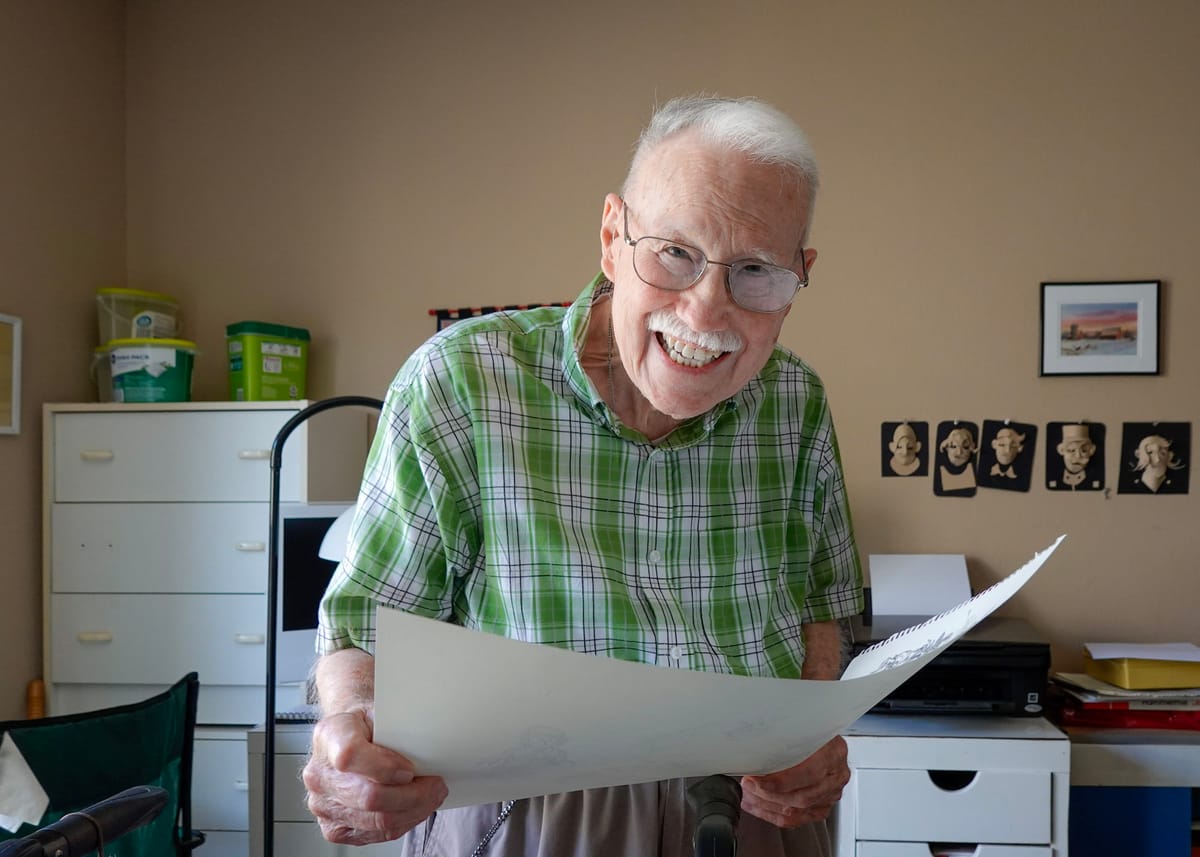
 The SHOUTSamantha Barrett
The SHOUTSamantha Barrett
 The SHOUTEmily Christensen
The SHOUTEmily Christensen



